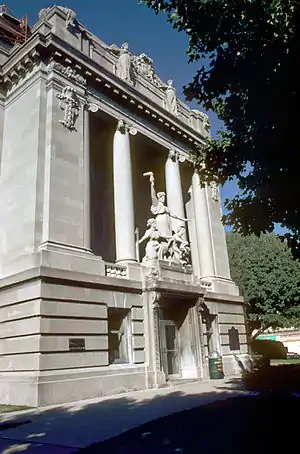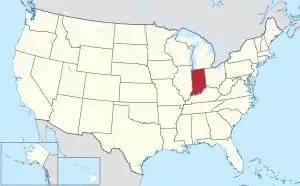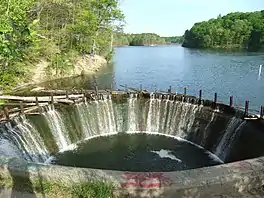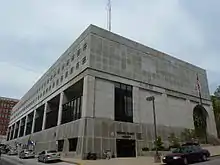Monroe County | |
|---|---|
 Monroe County courthouse in Bloomington, Indiana | |
 Seal | |
 Location within the U.S. state of Indiana | |
 Indiana's location within the U.S. | |
| Coordinates: 39°10′N 86°31′W / 39.16°N 86.52°W | |
| Country | |
| State | |
| Founded | 14 January 1818 |
| Named for | James Monroe |
| Seat | Bloomington |
| Largest city | Bloomington |
| Area | |
| • Total | 411.32 sq mi (1,065.3 km2) |
| • Land | 394.51 sq mi (1,021.8 km2) |
| • Water | 16.81 sq mi (43.5 km2) 4.09% |
| Population (2020) | |
| • Total | 139,718 |
| • Density | 340/sq mi (130/km2) |
| Time zone | UTC−5 (Eastern) |
| • Summer (DST) | UTC−4 (EDT) |
| Congressional district | 9th |
| Website | www |
| Indiana county number 53 | |
Monroe County is a county in the U.S. state of Indiana. In 1910 the US Census Bureau calculated the nation's mean population center to lie in Monroe County.[1] The population was 139,718 at the 2020 United States Census.[2] The county seat is Bloomington.[3] Monroe County is part of the Bloomington, Indiana, Metropolitan Statistical Area.
History
Monroe County was formed in 1818 from portions of Orange County. It was named for James Monroe,[4] fifth President of the United States, who was in that office from 1817 until 1825.
Demographics
| Census | Pop. | Note | %± |
|---|---|---|---|
| 1820 | 2,679 | — | |
| 1830 | 6,577 | 145.5% | |
| 1840 | 10,143 | 54.2% | |
| 1850 | 11,286 | 11.3% | |
| 1860 | 12,847 | 13.8% | |
| 1870 | 14,168 | 10.3% | |
| 1880 | 15,875 | 12.0% | |
| 1890 | 17,673 | 11.3% | |
| 1900 | 20,873 | 18.1% | |
| 1910 | 23,426 | 12.2% | |
| 1920 | 24,519 | 4.7% | |
| 1930 | 35,974 | 46.7% | |
| 1940 | 36,534 | 1.6% | |
| 1950 | 50,080 | 37.1% | |
| 1960 | 59,225 | 18.3% | |
| 1970 | 84,849 | 43.3% | |
| 1980 | 98,785 | 16.4% | |
| 1990 | 108,978 | 10.3% | |
| 2000 | 120,563 | 10.6% | |
| 2010 | 137,974 | 14.4% | |
| 2020 | 139,718 | 1.3% | |
| 2021 (est.) | 139,875 | 0.1% | |
| US Decennial Census[5] 1790–1960[6] 1900–1990[7] 1990–2000[8] 2010[9] | |||
As of the 2020 United States Census, there were 139,718 people and 56,399 households with an average of 2.34 persons per household in the county. The population density was 354.1 inhabitants per square mile (136.7/km2). As of July 1, 2021 there were 64,362 housing units of which 55.2% were owner-occupied. The racial makeup of the county was 86.0% white, 6.9% Asian, 3.9% black or African American, 0.3% American Indian, 0.1% Native Hawaiian and Other Pacific Islander, and 2.8% from two or more races. Those of Hispanic or Latino origin made up 3.8% of the population.[10]
According to the American Community Survey, as of 2021, there were 56,714 households with the average household size of 2.18 persons. Out of those 27,340 households were families with the average family size of 2.87 persons, 22.1% had children under the age of 18 living with them. A total of 37.3% of all households were householders living alone.[11]
The median income for a household in the county was $51,945 (in 2021 USD) and the per capita income was $30,609. Males had a median income of $52,263 versus $47,953 for females.[12]
About 10.6% of families and 22.8% of the population were below the poverty line, including 14.7% of those under age 18 and 6.2% of those age 65 or over.[13][14]
Geography
According to the 2010 census, the county has a total area of 411.32 square miles (1,065.3 km2), of which 394.51 square miles (1,021.8 km2) (or 95.91%) is land and 16.81 square miles (43.5 km2) (or 4.09%) is water.[15] The county terrain is low rolling hills, covered with vegetation and largely devoted to agricultural use or urban development. The eastern part is carved with drainages and gullies, leading to Griffy Lake.[16] The county's highest point is McGuire Benchmark, just NW of Bloomington, at 994 ft (303 m) ASL.[17]
Adjacent counties
Bodies of water

Monroe County is divided between the basins of the East Fork and West Fork of Indiana's White River.[18] The northern part drains to the West Fork; the southern part of the county drains to the East Fork, primarily via the Salt Creek and its tributaries, such as the Clear Creek (known as the "Jordan River" on Indiana University Bloomington campus).
Several artificial reservoirs have been constructed by damming the county's creeks. The largest is Monroe Lake, a large reservoir on Salt Creek in the southeastern part of the county. It is used both for recreational purposes and to supply the city with drinking water.[18] Until the late 1960s, the main source of water supply was the smaller Lake Lemon (constructed 1953), in the northeastern part of the county; it is now the backup water source and is mainly used for recreation.[19]
The third largest is Griffy Lake, on the northern slope of the county. Constructed in 1924 by damming Griffy Creek, it was Bloomington's main water source until 1954; it is now used primarily for recreation although it also serves as an emergency water source.[18][20][21] In 2012–2013, the lake was drained, the dam repaired, and the lake was refilled.
A smaller lake, Weimer (Wapehani) in the Clear Creek basin, was constructed for water supply purposes, but during most of its history was used purely for recreation - mainly fishing.[22] In 2017 authorities revealed plans to drain this lake permanently, as it was considered to be unsafe.[23] This was carried out in the summer of 2018.
Limestone has been quarried in Monroe County since 1826.[24] A number of abandoned limestone quarries in the county are now cliff-surrounded lakes (as seen in the 1979 film Breaking Away), stable without ongoing human intervention.
National protected areas

- Hoosier National Forest (part)
Natural wonders
- Buckner Cave
- Leonard Springs Nature Park, where the water of Sinking Creek reappears in springs[25]
Communities
Cities
Towns
Census-designated places
Unincorporated communities
- Arlington
- Broadview
- Buenavista
- Cascade
- Chapel Hill
- Clear Creek
- Dolan
- Eastern Heights
- Elwren
- Fairfax
- Fleener
- Forest Park Heights
- Garden Acres
- Handy
- Highland Village
- Hindustan
- Hoosier Acres
- Kirby
- Kirksville
- Knight Ridge
- Lancaster Park
- Leonard Springs
- Marlin Hills
- Modesto
- Mount Tabor
- New Unionville
- Ridgemede
- Sanders
- Smithville
- Stanford
- Sunny Slopes
- Unionville
- Van Buren Park
- Victor
- Wayport
- West Brook Downs
- Woodbridge
- Woodville Hills
- Yellowstone
Former communities
- Paynetown[26] at 39°04′30″N 86°25′47″W / 39.0749°N 86.4296°W[27] - flooded by Lake Monroe
Townships
Climate and weather
| Bloomington, Indiana | ||||||||||||||||||||||||||||||||||||||||||||||||||||||||||||
|---|---|---|---|---|---|---|---|---|---|---|---|---|---|---|---|---|---|---|---|---|---|---|---|---|---|---|---|---|---|---|---|---|---|---|---|---|---|---|---|---|---|---|---|---|---|---|---|---|---|---|---|---|---|---|---|---|---|---|---|---|
| Climate chart (explanation) | ||||||||||||||||||||||||||||||||||||||||||||||||||||||||||||
| ||||||||||||||||||||||||||||||||||||||||||||||||||||||||||||
| ||||||||||||||||||||||||||||||||||||||||||||||||||||||||||||
In recent years, average temperatures in Bloomington have ranged from a low of 19 °F (−7 °C) in January to a high of 86 °F (30 °C) in July, although a record low of −21 °F (−29 °C) was recorded in January 1985 and a record high of 110 °F (43 °C) was recorded in July 1936. Average monthly precipitation ranged from 2.66 inches (68 mm) in January to 5.12 inches (130 mm) in May.[28]
Government and politics

The county government is a constitutional body, and is granted specific powers by the Constitution of Indiana, and by the Indiana Code.
County Council: The fiscal body of the county government; controls spending and revenue collection in the county. There are four elected members representing districts and three members elected at-large. The council members serve staggered four-year terms. They are responsible for setting salaries, the annual budget, and special spending. The council also has authority to impose local taxes, in the form of an income and property tax that is subject to state level approval, excise taxes, and service taxes.[29][30]
Board of Commissioners: A three-member board serving as the executive and legislative body of the county. The commissioners are elected county-wide, in staggered four-year terms. The president of this board is the county's principal executive officer. The commissioners are charged with setting policy and managing the day-to-day functions of the county government.[29][30]
Court: The county maintains a unified circuit court with nine divisions and a court commissioner who handles civil cases. Judges must be members of the Indiana Bar Association; they are elected to six-year terms. Some court decisions can be appealed to the state level (appeals court, state supreme court).
County Officials: The county has several other elected offices, including sheriff, coroner, auditor, treasurer, recorder, surveyor, assessor, and circuit court clerk. They are elected county-wide to four-year terms. Members elected to county government positions are required to declare party affiliations and to be residents of the county.[30]
Monroe County is part of Indiana's 9th congressional district and is represented in Congress Republican Trey Hollingsworth.[31] It is part of Indiana Senate districts 37, 40 and 44;[32] and Indiana House of Representatives districts 46, 60 and 61.[33]
Courthouse
The Monroe County Courthouse is the seat of government for Monroe County and is the traditional center of Bloomington. The third courthouse to stand on the Downtown Square, the current courthouse was built in 1907 during a time of great prosperity. Wing & Mahurin designed the building.[34]
Politics
Monroe County traditionally leaned Republican. However, like many counties with large universities, it has trended strongly towards Democrats in recent years, voting for the Democratic nominee in 7 out of the last 8 presidential elections. In 2008, Barack Obama turned in the strongest showing for a Democrat since 1888. It has gone Democratic by large margins since then, and is now considered one of the few reliably Democratic counties in traditionally Republican Indiana. In recent years, only Marion County (Indianapolis) has been more Democratic.
| Year | Republican | Democratic | Third party | |||
|---|---|---|---|---|---|---|
| No. | % | No. | % | No. | % | |
| 2020 | 22,071 | 34.95% | 39,861 | 63.12% | 1,219 | 1.93% |
| 2016 | 20,592 | 35.23% | 34,216 | 58.53% | 3,646 | 6.24% |
| 2012 | 22,481 | 39.29% | 33,436 | 58.43% | 1,306 | 2.28% |
| 2008 | 21,118 | 33.32% | 41,450 | 65.39% | 819 | 1.29% |
| 2004 | 22,834 | 45.25% | 26,965 | 53.43% | 668 | 1.32% |
| 2000 | 19,147 | 47.61% | 17,523 | 43.57% | 3,550 | 8.83% |
| 1996 | 16,744 | 42.27% | 18,531 | 46.78% | 4,334 | 10.94% |
| 1992 | 16,661 | 38.22% | 19,712 | 45.22% | 7,214 | 16.55% |
| 1988 | 20,756 | 56.04% | 15,855 | 42.81% | 427 | 1.15% |
| 1984 | 21,772 | 59.12% | 14,719 | 39.97% | 335 | 0.91% |
| 1980 | 18,233 | 49.42% | 13,316 | 36.09% | 5,345 | 14.49% |
| 1976 | 18,938 | 53.06% | 16,609 | 46.53% | 148 | 0.41% |
| 1972 | 19,953 | 56.05% | 15,241 | 42.82% | 402 | 1.13% |
| 1968 | 13,752 | 50.78% | 10,789 | 39.84% | 2,539 | 9.38% |
| 1964 | 10,309 | 46.08% | 11,918 | 53.27% | 145 | 0.65% |
| 1960 | 14,513 | 65.42% | 7,535 | 33.97% | 136 | 0.61% |
| 1956 | 13,223 | 62.92% | 7,732 | 36.79% | 60 | 0.29% |
| 1952 | 12,072 | 60.59% | 7,745 | 38.87% | 108 | 0.54% |
| 1948 | 9,579 | 54.64% | 7,375 | 42.07% | 578 | 3.30% |
| 1944 | 8,993 | 55.77% | 6,809 | 42.23% | 323 | 2.00% |
| 1940 | 10,311 | 55.74% | 8,117 | 43.88% | 71 | 0.38% |
| 1936 | 8,842 | 48.82% | 9,220 | 50.91% | 48 | 0.27% |
| 1932 | 7,759 | 47.03% | 8,478 | 51.39% | 260 | 1.58% |
| 1928 | 8,883 | 67.00% | 4,317 | 32.56% | 59 | 0.44% |
| 1924 | 6,247 | 55.22% | 4,689 | 41.45% | 376 | 3.32% |
| 1920 | 5,633 | 53.65% | 4,751 | 45.25% | 116 | 1.10% |
| 1916 | 3,033 | 50.31% | 2,796 | 46.38% | 200 | 3.32% |
| 1912 | 1,388 | 25.19% | 2,396 | 43.48% | 1,727 | 31.34% |
| 1908 | 3,051 | 51.48% | 2,780 | 46.91% | 95 | 1.60% |
| 1904 | 3,042 | 55.81% | 2,286 | 41.94% | 123 | 2.26% |
| 1900 | 2,788 | 52.68% | 2,397 | 45.29% | 107 | 2.02% |
| 1896 | 2,510 | 50.20% | 2,422 | 48.44% | 68 | 1.36% |
| 1892 | 2,017 | 45.88% | 1,937 | 44.06% | 442 | 10.05% |
| 1888 | 2,054 | 51.50% | 1,815 | 45.51% | 119 | 2.98% |
Education
Monroe County Public Library operates branches at Bloomington and Ellettsville.[36]
Monroe County is home to Indiana University Bloomington.
Transportation
Major highways
 I-69
I-69 Indiana State Road 37
Indiana State Road 37 Indiana State Road 45
Indiana State Road 45 Indiana State Road 46
Indiana State Road 46 Indiana State Road 48
Indiana State Road 48 Indiana State Road 446
Indiana State Road 446
For many years Monroe County was one of the most populous counties in the USA which did not contain any US highways or Interstate highways. However, in December 2015 the I-69 extension was completed into the county and this distinction disappeared. The highway was further extended north into Morgan County in 2018.
Railways

Although Monroe County has a rich railway history, currently its only railway is the Indiana Rail Road, whose mainline crosses the county from the north-east to the south-west, with branches to a few industrial facilities.[37][38][39] There is no passenger service.
Between 1854 and 2004, an important north–south line connecting the Ohio River with Lake Michigan crossed Monroe County as well, serving Stinesville, Elletsville, Bloomington, Smithville, and Harrodsburg. It was operated by the Monon Railroad throughout much of the 20th century, and later by CSX. The last passenger service operating on this line was Amtrak's Floridian Chicago-Miami service, during 1972–1979. With the termination of this service in 1979, Monroe County lost passenger railway service. CSX continued to use this line for freight for another quarter of a century, but in 2004, it stopped using this line. Large parts of it have since been converted to trails. [24][40]
Air transport
- Monroe County Airport, southwest of Bloomington. Scheduled passenger service to this airport was terminated ca. 1997, and since then the airport has been used by general aviation only.
See also
References
- ↑ "Mean Center of Population for the United States: 1790 to 2000" (PDF). US Census Bureau. Archived from the original (PDF) on November 3, 2001. Retrieved September 17, 2011.
- ↑ "Monroe County, Indiana". United States Census Bureau. Retrieved June 2, 2023.
- ↑ "Find a County". National Association of Counties. Retrieved June 7, 2011.
- ↑ Gannett, Henry (1905). The Origin of Certain Place Names in the United States. US Government Printing Office. p. 212.
- ↑ "US Decennial Census". US Census Bureau. Retrieved July 10, 2014.
- ↑ "Historical Census Browser". University of Virginia Library. Retrieved July 10, 2014.
- ↑ "Population of Counties by Decennial Census: 1900 to 1990". US Census Bureau. Retrieved July 10, 2014.
- ↑ "Census 2000 PHC-T-4. Ranking Tables for Counties: 1990 and 2000" (PDF). US Census Bureau. Retrieved July 10, 2014.
- ↑ "Monroe County QuickFacts". US Census Bureau. Archived from the original on July 23, 2011. Retrieved September 25, 2011.
- ↑ "QuickFacts Monroe County, Indiana". US Census Bureau. Retrieved November 9, 2022.
- ↑ "2021 American Community Survey". US Census Bureau. Retrieved November 9, 2022.
- ↑ "2021 SELECTED ECONOMIC CHARACTERISTICS". US Census Bureau. Retrieved November 9, 2022.
- ↑ "POVERTY STATUS IN THE PAST 12 MONTHS OF FAMILIES". US Census Bureau. Retrieved November 9, 2022.
- ↑ "POVERTY STATUS IN THE PAST 12 MONTHS". US Census Bureau. Retrieved November 9, 2022.
- ↑ "Population, Housing Units, Area, and Density: 2010". US Census Bureau. Archived from the original on February 12, 2020. Retrieved July 10, 2015.
- ↑ Monroe County IN (google maps, accessed 20 December 2019)
- ↑ Monroe County IN (peakbagger.com, accessed 20 December 2019)
- 1 2 3 Water Basics: Stream Archived September 16, 2012, at the Wayback Machine (City of Bloomington)
- ↑ Lake Lemon Conservancy District (LLCD)
- ↑ Griffy Lake Nature Preserve
- ↑ Abandoned Water Sanitation Station, Water Pump; Bloomington IN Archived December 25, 2012, at archive.today, "The Other Side of Indiana"
- ↑ City of Bloomington Environmental Resource Inventory (COBERI) Archived June 9, 2013, at the Wayback Machine
- ↑ City plans to remove most of dam, lake in Wapehani bike park
- 1 2 Limestone Industry TIMELINE
- ↑ Leonard Springs Nature Park Archived September 17, 2012, at the Wayback Machine
- ↑ Salt Creek Valley - A New Place to Roost (Lake Monroe Oral History, accessed 11 August 2020)
- ↑ Monroe County IN (Google Maps, accessed 11 August 2020)
- 1 2 "Monthly Averages for Bloomington IN". The Weather Channel. Retrieved January 27, 2011.
- 1 2 Indiana Code. "Title 36, Article 2, Section 3". IN.gov. Retrieved September 16, 2008.
- 1 2 3 Indiana Code. "Title 2, Article 10, Section 2" (PDF). IN.gov. Retrieved September 16, 2008.
- ↑ Congressional Districts (NationalAtlas.Gov, accessed 21 May 2015)
- ↑ "Indiana Senate Districts". State of Indiana. Retrieved July 14, 2011.
- ↑ "Indiana House Districts". State of Indiana. Retrieved July 14, 2011.
- ↑ "Monroe County Courthouse – Bloomingpedia". www.bloomingpedia.org. Retrieved June 30, 2016.
- ↑ Leip, David. "Atlas of US Presidential Elections". uselectionatlas.org. Retrieved May 18, 2018.
- ↑ "Hours & Locations". Monroe County Public Library. Retrieved March 10, 2018.
- ↑ Indiana Railroad map
- ↑ State of Indiana 2012 railway system map (The branch to Elletsville, labeled "CSX", is presently abandoned.)
- ↑ Rail Density)
- ↑ Site Highlight: B-Line Trail in Bloomington